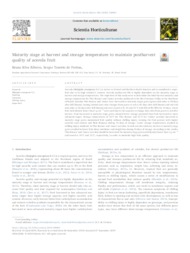Maturity stage at harvest and storage temperature to maintain postharvest quality of acerola fruit.
Maturity stage at harvest and storage temperature to maintain postharvest quality of acerola fruit.
Author(s): RIBEIRO, B. S.; FREITAS, S. T. de
Summary: Acerola (Malpighia emarginata D.C.) is native to Central and Northern South America and is considered a superfruit due to its high vitamin C content. Acerola postharvest life is highly dependent on the maturity stage at harvest and storage temperatures. The objectives of this study were to determine the ideal harvest maturity and storage temperature for 'Flor Branca' and 'Junko' acerolas produced in the São Francisco Valley in the Northeast of Brazil. Acerolas 'Flor Branca' and 'Junko' were harvested at maturity stages green (green skin color at 18 days after full bloom), turning (initial skin color changes from green to red at 20 days after full bloom) and red (red skin color at 22 days after full bloom) and were stored at 8, 10 and 12 °C with RH of 90?95% for 14 days. Green fruit with density lower than 1 g cm−3 were used due to the capacity to change skin color from green to red after harvest. Fruit harvested at maturity stage green showed better storage potential than fruit harvested at more advanced stages. Storage temperatures of 10 °C for 'Flor Branca' and 12 °C for ?Junko? acerolas harvested at maturity stage green maintained fruit quality without chilling injury, keeping the fruit greener with higher ascorbic acid content and flesh firmness during 14 days of storage. Lower storage temperatures resulted in chilling injury incidence in ?Flor Branca? and ?Junco? acerolas. In both acerola cultivars, harvest at maturity stage green resulted in lower fruit decay incidence and weight loss during 14 days of storage. According to the results, ?Flor Branca? and ?Junco? acerolas should be harvested the maturity stage green with density lower than 1 g cm−3 and stored at 10 °C and 12 °C, respectively, in order to maintain high fruit quality.
Publication year: 2020
Types of publication: Journal article
Unit: Embrapa Semi-arid Region
Observation
Some of Embrapa's publications are published as ePub files. To read them, use or download one of the following free software options to your computer or mobile device. Android: Google Play Books; IOS: iBooks; Windows and Linux: Calibre.
Access other publications
Access the Agricultural Research Database (BDPA) to consult Embrapa's full library collection and records.
Visit Embrapa Bookstore to purchase books and other publications sold by Embrapa.

